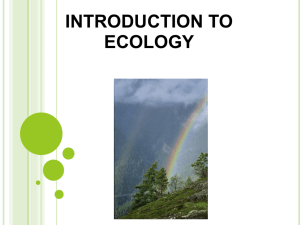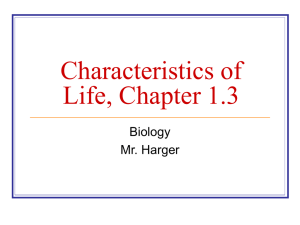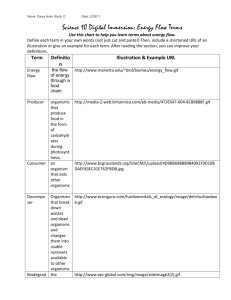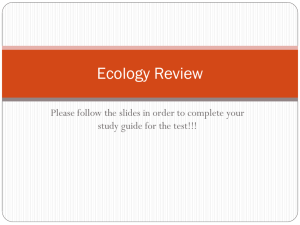Regents_Bio_Stuff_files/Ecology 2008
advertisement
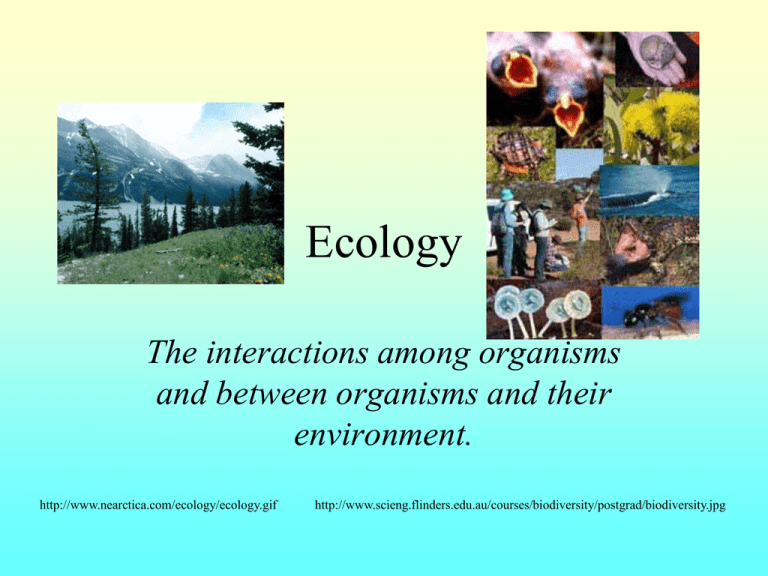
Ecology The interactions among organisms and between organisms and their environment. http://www.nearctica.com/ecology/ecology.gif http://www.scieng.flinders.edu.au/courses/biodiversity/postgrad/biodiversity.jpg Why study ecology? • Understanding ecology helps people make decisions about environmental issues: – Wildlife management – Deforestation – Managing natural resources http://www.kznwildlife.com/images/mngt_icon.gif What does ecology involve? • Biotic factors – all living organisms • Abiotic factors – non-living physical and chemical conditions (water, air, soil, etc.). http://www.bio.bris.ac.uk/research/community/ Life Organization • Subatomic particles • Electrons, Protons, Neutrons • Atoms • Molecules/Compounds • Macromolecules • Organelles • CELLS • • • • • • • Tissues Organs Organ Systems Organism Population Ecosystem Biosphere Ecology Levels • • • • • Individual Organisms Populations Communities Ecosystems Biosphere http://www.knowledgebank.irri.org/IPM/appecology/image3.gif Organism • Smallest unit of ecological study • Ecology: What adaptations did an organism evolve? http://www.gettysburg.edu/college_life/osa/orgs/acad%20clubs/biosphere/frog.jpg http://www.uga.edu/srel/Graphics/E.%20Box%20turtle.jpg Population • Group of organisms of the same: – Species – Time – Place • Ecology: What factors affect a population? Communities • All of the organisms inhabiting a particular area. • Ecology: How do populations in a community interact with one another? http://www.ufz.de/data/5120 Ecosystems • Includes both abiotic and biotic factors • Ex) a coral reef – Includes water, sunlight, coral, fish species • Ecology: How do energy and chemicals flow in an ecosystem? – Carbon cycle, water cycle, nitrogen cycle Biosphere • All Earth’s ecosystems • Ecology: Focus on global issues = The effect of climate change on living things. http://library.thinkquest.org/J002558F/biosphere.jpg Biosphere Divisions: Habitats • Habitats: specific environments in which organisms live • Due to the differences in abiotic factors: – – – – Temperature Soil type Water availability Sunlight availability http://www.les-snats.com/milieu-et-habitat/milieu-habitat.jpg Sunlight • Provides warmth, light, and is the primary energy source. • Powers photosynthesis: done by producers – Ex) plants and protists • That energy is stored in the producers and consumed by others (energy is transferred) – (will cover later) http://oceanworld.tamu.edu/NMEA_Talk/NMEA%20Talk%2020032.jpg Water • Essential to all life • Humans consist of 70% water! • Water can dissolve gases (oxygen) and salts which are also important to organisms. • Organisms evolve ways to regulate water: – Pines: have thick cuticles – Lizards: scaly skin Wind • Can stir up ponds, lakes, and streams (bring nutrients up from bottom) • Disperse pollen and seeds • Affect organisms – Flagging of trees http://southadventure.tripod.com/flag_tree.jpg CLIMATE • Energy from the sun warms the surface of the Earth • Temperature differences at different latitudes – Results from angle of incoming sunlight • Equator receives most direct sunlight, poles least • So what causes the seasons to change? Population & Community Ecology http://www.nearctica.com/ecology/pops/sheep.gif Populations • Definition: Group of same species in one area at one time. • Ecologists need to define geographic boundaries. – Walls of an aquarium in which algae grows – Deer in a particular state – HIV infection (humans) in one nation or world Population Growth • Exponential Growth: population multiplies by a constant factor at constant time intervals. • Space is a limiting factor: a condition that can restrict a population’s growth – Lily pads growing across a pond will reach a point where the surface of water is completely covered and no more can grow. http://photos.atkmotors.com/Lily%20Pad%203.jpg Carrying Capacity • Definition: the number of organisms in a population that the environment can maintain, or “carry,” with no net increase or decrease. • Pop’s that approach carrying capacity: – Birth rate decrease – Death rate increase http://el.erdc.usace.army.mil/aqua/apis/biocontrol/image/minmax.gif Factors Affecting Population Growth • Density-dependent factor- more individuals in a population (more dense), more limited the population becomes. – Food/Resources • Density-independent factors- affect pop. but not related to pop. density – weather Population Growth Cycles • Some pop.’s rapidly increase and then rapidly decrease (crash) • Some cycle: – predator-prey dynamic • Lynx & snowshoe hare http://members.shaw.ca/grizzlyjake/images/lynx%20chasing%20hare.jpg • Human Population Growth • For most of human history, pop. growth is very small (or not at all) • 1650 C.E. (common era) – 500 million ppl. • Improvements in health care, sanitation & nutrition allow longer life expectancies & greater survival Human Populations • • • • 1650-1850AD – 1 billion ppl. 1930AD – 2 billion ppl. 1980AD – 4 billion ppl. 2006 AD – 6,500,000,000 people on Feb.24, 2006 at 7:16pm • Present http://math.berkeley.edu/~galen/popclk.html • Oct. 18, 2012 at 4:36pm – 7,000,000,000 • Currently growing 75mill. ppl per year Species Interact in Biological Communities http://www.ucsc.edu/currents/01-02/art/moth.02-06-24.224.jpg Competition • Two or more species in one community fight for a limited resource. • Ex) African Savannah: many species rely on grasses which is a limiting resource. Competitive Exclusion • When two species compete for a limiting resource, and one outcompetes the other. • Ex) 2 types of Paramecium: – P.aurelia and P. caudatum – Fed same amt. of food: • Separate- both thrives • Together- P.aurelia could consume food faster & outcompeted (succeeded over) P. caudatum Niche • An organism’s role in its habitat • Includes: – Food sources – Time of day it’s most active – Any factor specific to organism’s life http://www.tarleton.edu/~range/Cook%20Pictures/Photo%20Slides_4/184%20coral%20bean.jpg Predation • Interaction in which one organism eats another. – Lion & egret • Predator adaptations: – Fast & agile – Acute senses (exrattlesnakes have heat sensing organs behind each eye) – Some camouflage – Claws, teeth, fangs & stingers Prey Adaptations • To avoid being eaten: – – – – – Retreat to safe places Camouflage to hide from predators Warning Coloration Poisonous chemicals Mimicry of other dangerous species • Hawk moth puffs up, weaves back and forth, and hisses like a snake (looks like one!) Symbiotic Relationships • Close interactions between species in which one of the species lives in or on the other. • 3 types – Parasitism – Mutualism – Commensalism http://www.dep.state.fl.us/parks/OPG/maclaygardens/photos/wallpaper/1024-PL-MAC-Symbiosis-MarkFerrulo.jpg http://www.uidaho.edu/so-id/entomology/clb%20parasite.jpg Parasitism • One organism, the parasite, obtains its food at the expense of another organism (host). – Mosquitoes – Tapeworms – Leaches • Natural selection works on both parasites & hosts! – Parasite better at obtaining food, host better at defending (plants produce allelochemicals). http://www.organicnutrition.co.uk/images/parasite-hookworm.gif Mutualism • Both organisms benefit – Human large intestine & bacteria (bacteria feed on nutrients we consume, but they produce vitamins for us) – Lichens Commensalism • One organism benefits while the other is unaffected (not helped or harmed). – Crab places seaweed on its back to hide (seaweed unaffected) – Mites on our eyelashes – Barnacles on a whale http://www.visions-of-science.co.uk/photos/Close-up%202nd%20-%20Eyelash%20mites.jpg Primary Succession • When a community arises in a lifeless area that has no soil. – New islands from erupting volcanoes (Hawaii) – Clear-cut land • 1st to arise= pioneer organisms – Usually photosynthetic, why? – Lichens- create soil & make it possible for other organisms to live in the area. Primary Succession • Succession of organisms: – Lichens>mosses>grasses>shrubs>trees • How did those new organisms get there? – Carried by animals – Carried by wind • From barren ground to a deciduous forest can take hundreds or thousands of years!!! • How long does it take to clear that land? http://www.anselm.edu/homepage/jpitocch/genbios/primsucc6crat52603.jpg http://www.geo.arizona.edu/Antevs/nats104/00lect20sucn1.gif http://www.geo.arizona.edu/Antevs/nats104/00lect20sucn2.gif Energy Flow & Chemical Cycling http://www.comm.media.state.mn.us/bookstore/shore/html_in/in_img/ecosystem.jpg 3 Types of Organisms • Producers: photosynthetic, convert light energy from the sun to chemical energy in organic compounds – Plants – Phytoplankton • Consumers: obtain energy by consuming producers or other consumers • Decomposers: break down wastes and dead organisms 3 Types Consumers • Herbivore: eats only producers (horse) • Carnivore: eats only other consumers (lion) • Omnivore: eats both producers & consumers (bear) http://www.alanandsandycarey.com/Wildlife/Bears/Grizzly%20Bears/images/Grizzly%20Bear%20feeding%20on%20Rose%20Hips%20Montana.jpg Food Chains • Energy transfer between trophic levels • Trophic Levels – Producers-flowers, phytoplankton – Primary consumersgrasshopper, zooplankton – Secondary consumers-mouse, herring – Tertiary consumers-snake, cod – Quaternary consumers-hawk, killer whale http://cse.cosm.sc.edu/env_sci/Resources/L_Sus_Res/Soil/trophic.jpg Trophic Levels Explained • Primary Consumer: consumer feeds directly on producers • Secondary Consumer: feeds on primary consumers • Tertiary Consumer: feeds on secondary consumers http://pubs.usgs.gov/of/1998/of98-805/lessons/chpt7/energy-sm.gif Decomposers • At each trophic level, organisms produce waste and eventually die. • Scavengers: consume dead organisms – Rodents, insects, crayfish, catfish, & vultures • Main decomposers: Bacteria & Fungi Food Web • Diagrams that show the feeding patterns of all food chains in one area • Arrows shows the transfer of energy Productivity of Ecosystems • Biomass: the amount of organic material produced on earth (billions of kg) Pyramid of bio mass • Most biomass is at the BOTTOM of pyramid http://fig.cox.miami.edu/Faculty/Dana/energypyramid.jpg Pyramid of Energy • The most energy is at the bottom of the food chain Ecological Pyramids • Energy is spent at each step of the food web • Some energy is transferred from the lower trophic level to the higher • Most energy is lost • Average: 10% of energy is transferred to the next trophic level Carbon & Oxygen Cycle • In atmosphere, carbon is inorganic in the form of CO2 • Producers use CO2 to make organic compounds (photosynthesis) • Organisms break down organic compounds and release CO2 – Cell respiration for energy or decomposers produce this when breaking down detritus Carbon & Oxygen Cycle • Nonliving processes also contribute to cycle: – Burning fossil fuels (C in organic compounds) – Burning wood (human activity or forest fires) – Volcanic eruptions http://upload.wikimedia.org/wikipedia/en/5/55/Carbon_cycle-cute_diagram.jpeg Carbon Cycle Impacts • Industrialized nations: release carbon in atmosphere by burning fossil fuels • Deforestation: clearing of forests for – Agriculture – Lumber – Etc • Problem: release CO2 into atmosphere, remove plants that absorb CO2 Carbon Cycle Impacts • Human contribution to carbon cycle: – 80% of carbon in atmosphere: burning fossil fuels – 20%: burning after deforestation • Problem: CO2 allows sunlight to enter atmosphere, but does not let heat escape after reflecting & radiating off earth’s surface Greenhouse Effect • CO2 acts like the glass of greenhouses: – Sunlight passes through – Heat cannot escape – Earth’s average temperature is rising • Global Warming – Overall rise of Earth’s temperature Global Warming • A few degrees change: – – – – Melting of glaciers Sea levels rise Change in precipitation patterns Biome boundaries shift http://www.environment.sa.gov.au/sustainability/images/greenhouse_effect.jpg Nitrogen Cycle • 80% Earth’s gas is N2(gas) • Nitrogen Used to make AMINO ACIDS which make… • PROTEINS! • Nitrogen Fixation: convert N2 gas to ammonia (NH3) – Nitrogen fixing bacteria: live in nodules of peas, beans, alfalfa & clover (in soil) http://www.windows.ucar.edu/earth/climate/images/nitrogencycle.jpg Nitrogen Cycle Impacts • Adding large amounts of nitrogen compounds into the water and soil – Fertilizers • Fertilizers added to crops can run off into streams & ponds – – – – Allows rapid growth of algae (algae blooms) Algae die, bacteria decompose & use up oxygen Low oxygen=can’t support other organisms (fish) a.k.a. - EUTROPHICATION http://www.bbc.co.uk/schools/gcsebitesize/img/bieutrophication.jpg Nitrogen Cycle Impact • Smokestacks & car exhaust contain nitrogen and sulfur compounds – Combine with water forming nitric acid and sulfuric acid that precipitates back to Earth’s surface: acid rain – Clean Air Act http://www.dec.state.ny.us/website/dar/ood/acidrain.gif Water Cycle • Nonliving processes play a major role • Sun energy evaporates water from land and water surfaces – Add gaseous water vapor to atmosphere – As cools, water vapor condenses: precipitation (rain, snow, hail or sleet) – Plants absorb fresh water from soil – Consumers eat and drink water Water Cycle • Large amounts of water leaves plants via transpiration. • What is transpiration??? – Evaporation of water from plant leaves (out through stomata) – 200L of water can leave a maple tree on a hot day • Water not obtained by organisms, flows into streams, rivers, oceans and the cycle continues. http://www.anselm.edu/homepage/jpitocch/genbios/54-16-WaterCycle-L.gif Water Cycle • Deforestation: reduces transpiration • Use of water from aquifers and rivers: can be faster than what the water cycle takes to replace it http://www.geocities.com/cgwharton2004/deforestation.jpg Pollution • Addition of substances to environments that result in a negative effect Biological Magnification • Process by which pollutants become more concentrated in higher trophic levels of a food web • DDT-1971: pesticide that stores in fats. – Caused eggs of pelicans, ospreys, and eagles to be easily broken – Population declines – Surviving offspring received DDT also, why? http://www.glerl.noaa.gov/res/PandP/1996-97/zebra-fw-f1.gif Damage to the Ozone Shield • Ozone (O3) layer: 17-25 km above Earth’s surface and absorbs ultraviolet radiation • UV light can cause mutations in organisms • What are mutations? • Ozone layer has been recorded to be thinning since the 1970s • CFCs (chlorofluorocarbons): in aerosol cans, refrigeration units, etc http://www.gsfc.nasa.gov/gsfc/earth/pictures/arctictemps/globe.jpg Ozone Layer • CFCs destroy ozone – Skin cancer – Cataracts – Crop damage • Nearly 200 nations are working to eliminate ozone-destroying chemicals • http://www.epa.gov/ozone/science/hole/holeani m.html Conservation Biology • Biodiversity: encompasses the variety of life on earth • Why does biodiversity matter? – – – – Species in an ecosystem are interconnected Depend on the community for food, shelter, etc One loss of species, can affect all others 25% of medicines from plants in U.S. Biodiversity Importance • Rosy Periwinkle in the rain forests of Madagascar: – Childhood leukemia – Hodgkin's disease (cancer of lymphatic system) • U-tree (produces compounds also used for slowing cancer cells) Threats to Biodiversity • 1.5 million species today • Species disappearing at dramatic rates: – 11% of 9,040 birds are endangered – 680 of 20,000 plants species endangered – 20% of freshwater fishes endangered Habitat Destruction • As the human population grows, more land needed for: – Agriculture – Roads – Communities • Habitat fragmentation: preventing species from reaching resources or each other • Animation:http://bcs.whfreeman.com/thelif ewire/content/chp54/5402004.html Introduced Species • Introduced species (exotic species) often prey on or compete with native species • Starlings & Sparrows brought from Europe: – compete with bluebirds for nesting sites – Bluebird population decline http://www.science-house.org/kudzu/kudzu-car.jpg http://nationalatlas.gov/articles/biology/IMAGES/kudzu.gif Human Activities • Introduced Species, aka= exotic species – Organisms that humans move from the species’ native locations to new geographic areas, either intentionally or accidentally. – Intentional: • Kudzu Japanese Plant: introduced in the 1930s to control erosion in irrigation canals. Now grows out of control! – Accidental: • Lamprey in the Great Lakes Overexploitation • Harvesting or hunting a species to such a small number that they may not be able to repopulate – White rhino • Poachers: illegally hunt animals and sell animal products for money (elephant tusks and rhino horns) Conservation Biology • Application of biology to counter the loss of biodiversity • Focus on “hot spots:” small geographic areas with high concentration of species • 1.5% of Earth’s land area • Biologists, lawmakers, and local communities try to conserve “hot spots” Conservation Biology • Zoned reserves: areas of lands that is undisturbed by humans • Buffer zones: surround zoned reserves and have minimal impact by humans – Costa Rican Government- world leader in establishing zoned areas – Conserved 80% of natural species Conservation Biology • Sustainable Development: Developing natural resources so they can renew themselves and be available for the future. – Forest corridor through crop (keep connection between two parts of an ecosystem) – Timber harvesting from mature trees only
